Hotpoint FQ 860.1 User Manual

Operating Instructions
OVEN
Contents
GB
|
|
|
|
|
|
Installation, 2-3 |
|
|
|
DK |
|
|
|
||
GB |
|
|
NO |
|
Positioning |
||
|
|
|
|
|
|
Electrical connections |
|
English,1 |
Dansk, 12 |
Norsk,23 |
|||||
Description of the appliance, 4 |
|||||||
|
|
|
|
|
|
||
FI |
|
SE |
|
|
|
Overall view |
|
|
|
|
|
Control panel |
|||
|
|
|
|
|
|
||
|
|
|
|
|
|
|
|
Suomi, 34 |
Svenska, 45 |
|
|
Start-up and use, 5 |
|||
|
|
|
|
|
|
Starting the oven |
|
|
|
|
|
|
|
Data plate |
|
F86.1
F86.1 IX FQ 860.1 NE FZ 860.1 NE
FZ 860.1 IX NE
The electronic cooking programmer, 6
Cooking modes, 7-9
Cooking modes
Practical cooking advice
Cooking advice table
Precautions and tips, 10
General safety Disposal
Respecting and conserving the environment Assistance
Maintenance and care, 11
Switching the appliance off Cleaning the appliance Cleaning the oven door Replacing the light bulb
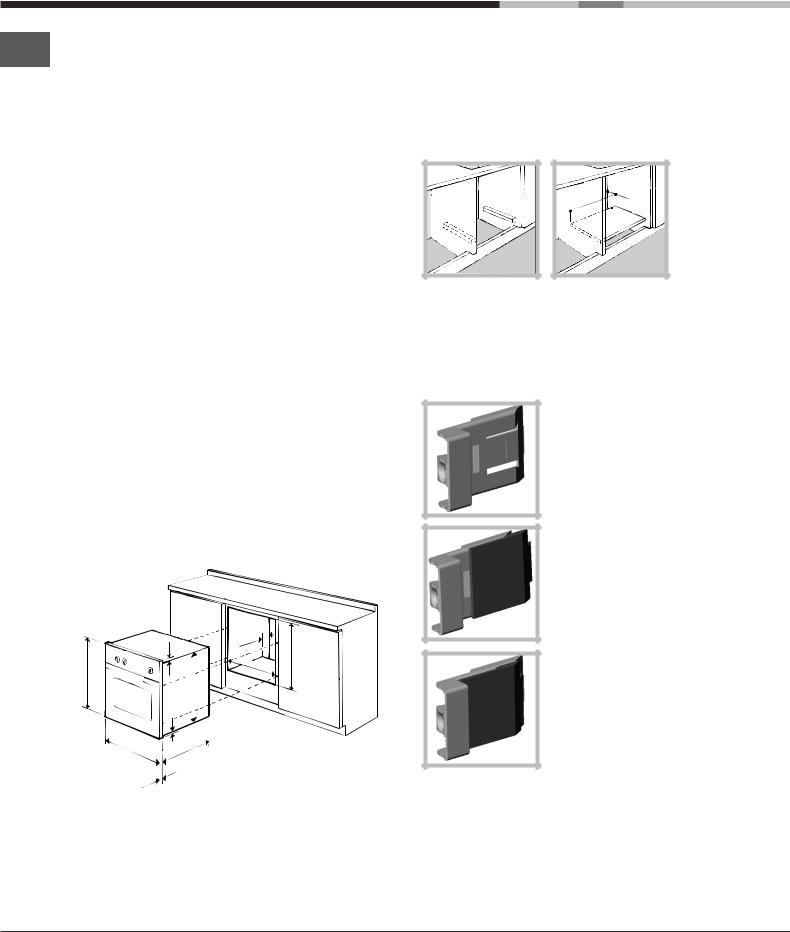
Installation
Before placing your new appliance into operation GB please read these operating instructions carefully.
They contain important information for safe use, for installation and for care of the appliance.
Please keep these operating instructions for future reference. Pass them on to possible new owners of the appliance.
Positioning
Keep packaging material out of the reach of children. It can become a choking or suffocation hazard. see Precautions and tips).
! The appliance must be installed by a qualified person in compliance with the instructions provided. Incorrect installation may cause harm to persons, animals or may damage property.
Fitting the appliance
Use the appropriate cabinet to ensure that the appliance functions properly.
•The panels adjacent to the oven must be made of heat-resistant material.
•Cabinets with a veneer exterior must be assembled with glues which can withstand temperatures of up to 100°C.
•To install the oven under the counter (see diagram) and in a kitchen unit, the cabinet must have the following dimensions:
mm.23 |
. |
mm. |
|
mm |
|
|
45 |
|
mm.595 |
|
|
mm.567 |
558 |
mm. |
593 |
|
|
|
||||
|
|
|
|
|
|
|
|
595 |
|
5 mm. |
|
|
|
|
mm. |
. |
|
|
|
|
|
|
mm |
|
|
|
|
|
|
|
545 |
|
|
|
|
|
. |
|
|
|
|
|
|
mm |
|
|
|
|
|
24 |
|
|
|
|
|
! The appliance must not come into contact with electrical parts once it has been installed.
The consumption indications on the data plate have been calculated for this type of installation.
Ventilation
To ensure good ventilation, the back panel of the cabinet must be removed. It is advisable to install the oven so that it rests on two strips of wood, or on a completely flat surface with an opening of at least 45 x
560 mm (see diagrams).
. |
45 |
mm |
mm |
|
|
|
. |
|
560 |
|
|
Centring and fastening
Position the 4 tabs on the side of the oven according to the 4 holes of the outer frame. Adjust the tabs according to the thickness of the cabinet side panel, as shown below:
thickness of 20 mm: take off the removable part of the tab
(see diagram)
thickness of 18 mm: use the first groove, which has already been set in the factory (see
diagram)
thickness of 16 mm: use the second groove (see diagram)
Secure the appliance to the cabinet by opening the oven door and putting 4 screws into the 4 holes of the outer frame.
! All parts which ensure the safe operation of the appliance must not be removable without the aid of a tool.
2
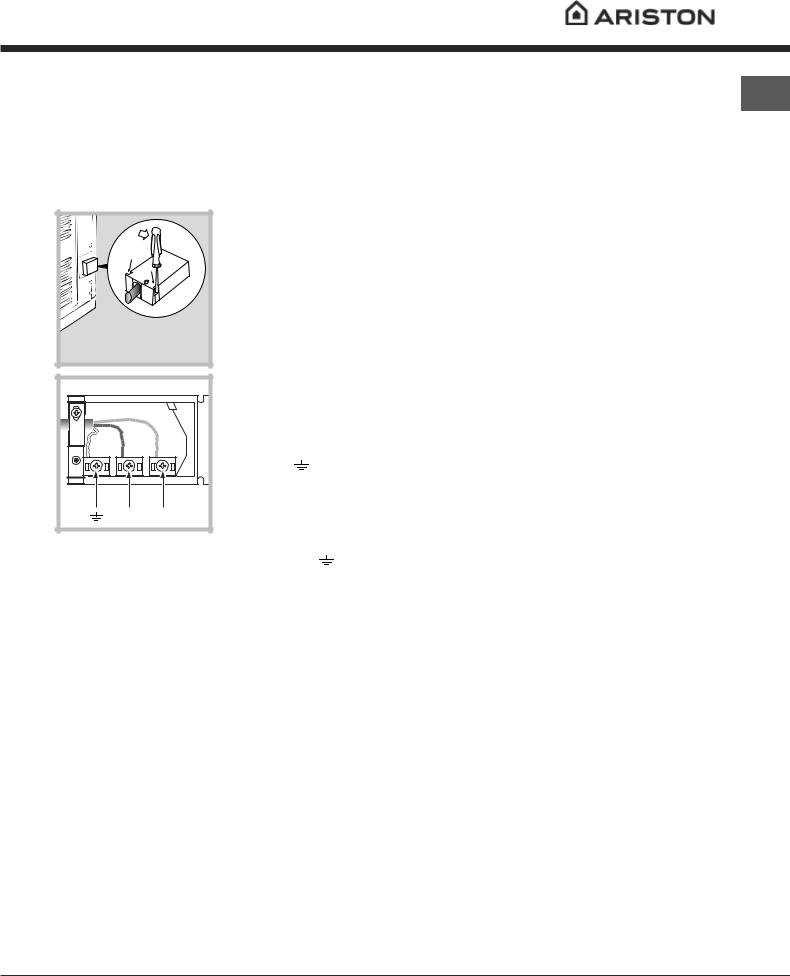
Electrical connections
! Ovens equipped with a three-pole power supply cable are designed to operate with alternating current at the voltage and frequency indicated on the data plate located on the appliance (see below).
Fitting the power supply cable
1. Open the terminal board by inserting a screwdriver into the side tabs of the cover. Use the screwdriver as a lever by pushing it down to open the cover
(see diagram).
|
|
2. Install the power |
|
|
|
|
supply cable by |
|
|
|
|
loosening the cable |
|
|
|
|
clamp screw and the |
||
|
|
three wire contact |
|
|
|
|
screws L-N- . Connect |
||
|
|
the wires to the |
|
|
|
|
corresponding terminals: |
||
N |
L |
the Blue wire to the |
|
|
terminal marked (N), the |
||||
|
|
|||
|
|
Brown wire to the |
|
|
terminal marked (L) and the Yellow Green wire |
to |
|||
the terminal marked (see diagram). |
|
|||
3.Secure the cable by fastening the clamp screw.
4.Close the cover of the terminal board.
Connecting the supply cable to the mains
GB
Install a standardised plug corresponding to the load indicated on the data plate (see side).
The appliance must be directly connected to the mains using an omnipolar circuit-breaker with a minimum contact opening of 3 mm installed between the appliance and the mains, suitable for the load indicated and complying with current electrical regulations (the earthing wire must not be interrupted by the circuitbreaker). The supply cable must not come into contact with surfaces with temperatures higher than 50°C.
! The installer must ensure that the correct electrical connection has been made and that it is compliant with safety regulations.
Before connecting to the power supply, make sure that:
•The appliance is earthed and the plug is compliant with the law.
•The socket can withstand the maximum power of the appliance, which is indicated on the data plate (see below).
•The voltage must be in the range between the values indicated on the data plate (see below).
•The socket is compatible with the plug of the appliance. If the socket is incompatible with the plug, ask an authorised technician to replace it. Do not use extension cords or multiple sockets.
!Once the appliance has been installed, the power supply cable and the electrical socket must be easily accessible.
!The cable must not be bent or compressed.
!The cable must be checked regularly and replaced by authorised technicians only (see Assistance).
!The manufacturer declines any liability should these safety measures not be observed.
3
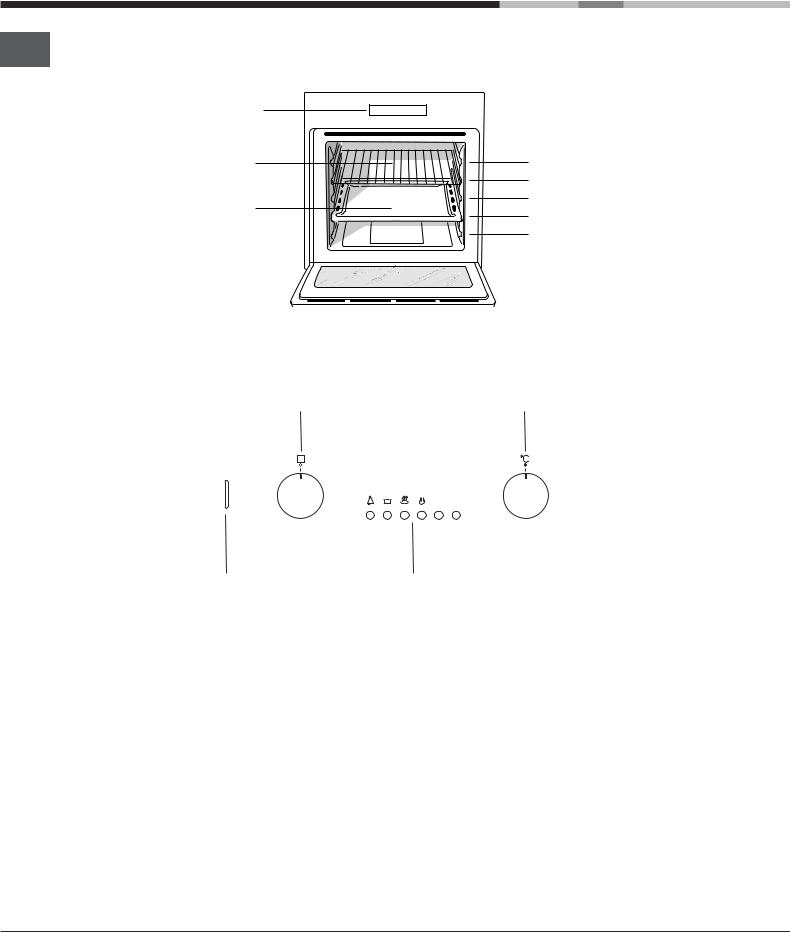
Description of the appliance
Overall view
GB
Control panel |
GUIDES for the |
|
|
sliding racks |
|
GRILL |
position 5 |
|
|
position 4 |
|
DRIPPING PAN |
position 3 |
|
position 2 |
||
|
||
|
position 1 |
Control panel
SELECTOR |
THERMOSTAT |
||||||
Knob |
Knob |
||||||
|
|
|
|
|
|
|
|
|
|
|
|
|
|
|
|
|
|
|
|
|
|
|
|
|
|
|
|
|
|
|
|
|
|
|
|
|
|
|
|
Indicator light |
ELECTRONIC |
THERMOSTAT |
Programmer |
4

Start-up and use
! The first time you use your appliance, heat the empty oven with its door closed at its maximum temperature for at least half an hour. Ensure that the room is well ventilated before switching the oven off and opening the oven door. The appliance may produce a slightly unpleasant odour caused by the burning away of protective substances used during the manufacturing process.
Starting the oven
1.Select the desired cooking mode by turning the SELECTOR knob.
2.Select the desired temperature with the THERMOSTAT knob. See the Cooking advice table for cooking modes and the suggested cooking temperatures (see Cooking Modes).
3.When lit, the THERMOSTAT indicator light indicates that the oven is heating up to the temperature set.
4.You may do the following during cooking:
-change the cooking mode by turning the SELECTOR knob.
-change the temperature by turning the THERMOSTAT knob.
-stop cooking by turning the SELECTOR knob to the “0” position.
!Never put objects directly on the oven bottom to avoid damaging the enamel coating.
!Always place cookware on the rack(s) provided.
Should the appliance be equipped with an |
|
||||
GB |
|||||
electronic programmer, to use the electric oven, just |
|||||
press button |
|
(the |
symbol will appear on the |
|
|
|
|
||||
display) before selecting the desired cooking function.
Cooling ventilation
In order to cool down the external temperature of the oven, some models are fitted with a cooling fan that blows out air between the control panel and the oven door.
! Once the cooking has been completed, the cooling fan remains on until the oven has cooled down sufficiently.
Oven light
It goes on when selecting  with the SELECTOR knob. It stays on when a cooking mode is selected.
with the SELECTOR knob. It stays on when a cooking mode is selected.
DATA PLATE
width 43.5 cm
Dimensions height 32 cm depth 41,5 cm
Volume |
lt. 58 |
|
|
|
|
|
|
|
|
||
Electrical |
voltage: 220-240V ~ 50Hz |
||||
maximum power absorbed |
|||||
connections |
|||||
2800W |
|
|
|
||
|
|
|
|
||
|
|
|
|
||
|
Directive 2002/40/EC on the label |
||||
|
of electric ovens. |
||||
|
Standard EN 50304 |
||||
ENERGY LABEL |
Energy consumption for Natural |
||||
convection – heating mode: |
|||||
|
Convection mode. |
|
|
||
|
Declared energy consumption for |
||||
|
Forced convection Class – heating |
||||
|
mode: |
Baking. |
|||
This appliance conforms to the following European Economic Community directives:
- 73/23/EEC of 19/02/73 (Low Voltage) and subsequent amendments;
- 89/336/EEC of 03/05/89 (Electromagnetic Compatibility) and subsequent amendments;
-93/68/EEC of 22/07/93 and subsequent amendments.
-2002/96/EC
5

The electronic cooking programmer
|
This feature allows you to program the oven or the grill |
|
GB |
||
as follows: |
||
|
• delayed cooking time for a specified period; |
|
|
||
|
• immediate start for a specified period; |
|
|
• timer. |
|
|
Button Functions: |
|
|
H : Timer with hours and minutes; |
|
|
$ : cooking time; |
|
|
% : end cooking time; |
|
|
(: Manual change; |
|
|
) : set cooking time (to count down); |
|
|
* : set cooking time (to start from zero) |
|
|
How to reset the digital clock |
|
|
After the appliance has been connected to the power |
|
|
supply, or after a power cut, the clock display will |
|
|
automatically reset to 0:00 and begin to blink. |
•Press the $ and %buttons consecutively and
then reset the time (within 4 seconds) using the )and * buttons.
The button * advances the hours. The button ) decreases the hours.
The time can also be changed in the following two ways:
1. Repeat all of the steps above.
2. Press the ( button, and then use the ) and * buttons to reset the time.
Manual operation of the oven
Once the time has been set, the programmer automatically switches to manual mode.
Note: Press the ( button to restore the manual mode after every “Automatic” cooking session.
Delayed cooking time for a specified period
The total cooking time as well as the time at which the cooking will finish must be set. If we assume that the time display reads10:00:
1.Turn the oven control knob to the setting and temperature desired (example: static oven mode at 200°C).
2.Press the button $ and then set the cooking time (within four seconds) using the ) and * buttons. Supposing the cooking time is set to 30 minutes, the display will read as follows:
+
Release the button, and within 4 seconds, the current time will reappear with the msymbol along with the word “auto” 3. Press the button % and then use the ) and * buttons to set the time for when the cooking program should
end. Let us imagine this time to be 1:00 p.m.
=
4.After the button has been released, the current time will be displayed after approximately 4 seconds:
?
When “auto” is on, it indicates that the length of cooking time and the time it is due to finish have been programmed in automatic mode. At this point, the oven will turn on automatically at 12:30 and turn off after 30 minutes. When the oven is turned on, the symbol m will be displayed for the entire cooking time. The cooking duration can be displayed at any time by pressing the button $ , and the time it is due to finish may be displayed by pressing the button % .
Once cooking is completed, the timer will ring; to turn it off, simply press any button except the ) and *
buttons.
Immediate start for a specified period
By programming just the duration (points 1 and 2 of the “Delayed cooking time for specified period” section), cooking will begin immediately.
To cancel a cooking schedule already programmed
Press the $ button, and use the ) button to set the time to:
,
then press the manual cooking mode button (.
Timer Feature
The timer feature allows you to enter a specific amount of time and begins to count down. This feature does not turn the oven on or off; it merely sounds when the time has elapsed.
When the button “ has been pressed, the display will read as follows:
,
Then use the * and ) buttons to set the desired time. As soon as the button has been released, the timer will start to count down and the current time will be displayed.
.
After the time has expired, an audible signal will be emitted, which can be turned off by pressing any button (except the * and ) buttons). At this point the symbol H will also turn off.
Correction/Cancellation of data
•The data entered can be changed at any time by pressing the corresponding button and the * or ) buttons.
•When the data for the cooking duration is cancelled, the data for the time cooking is due to end is also cancelled automatically, and vice versa.
•If the oven has already been programmed, it will not accept times for the end of cooking which are before the start of the programmed cooking process.
6
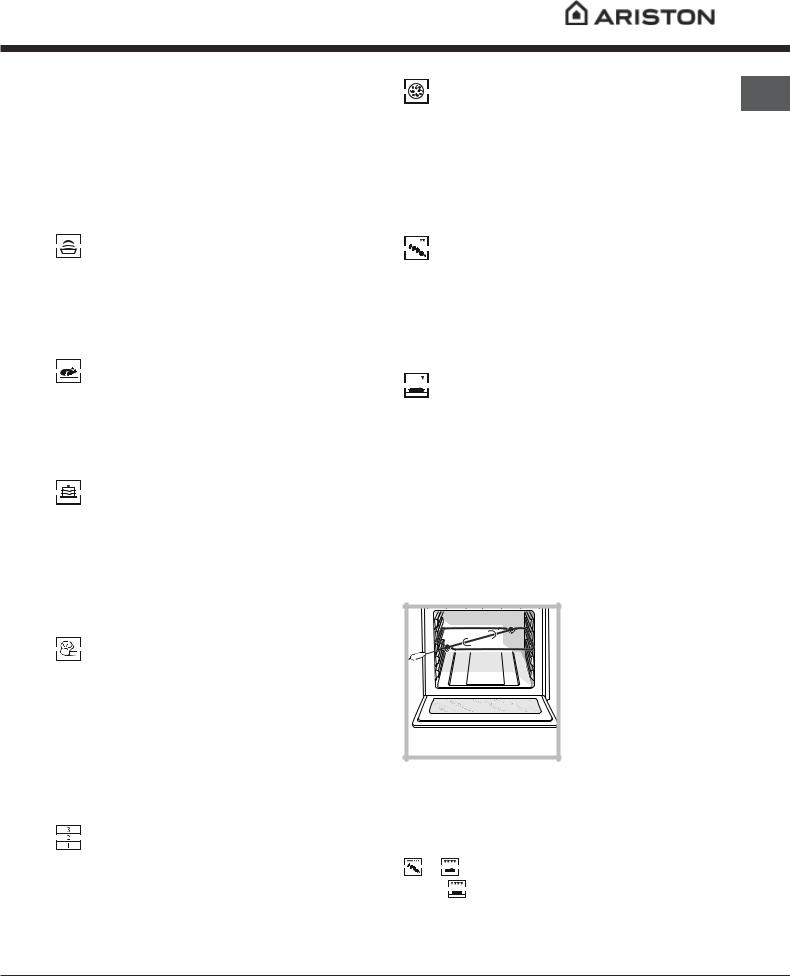
Cooking modes
Cooking modes
! A temperature value can be set for all cooking modes between 60°C and Max, except for
•BARBECUE (recommended: set only to MAX power level);
•GRATIN (recommended: do not exceed 200°C).
LEAVENING mode
The oven reaches and maintains a temperature of 40°C irrespective of the position of the THERMOSTAT knob. This mode is ideal for leavening dough made with yeast.
TRADITIONAL OVEN mode
Both the top and bottom heating elements will come on. With this traditional cooking mode, it is best to use one cooking rack only: if more than one rack is used, the heat distribution will be uneven.
BAKING mode
The rear heating element and the fan come on, guaranteeing the distribution of heat delicately and uniformly throughout the oven. This mode is ideal for baking and cooking temperature sensitive foods such as cakes that need to rise and to prepare certain tartlets on 3 shelves simultaneously.
 FAST COOKING mode
FAST COOKING mode
The heating elements and the fan come on, guaranteeing the distribution of heat consistently and uniformly throughout the oven.
Pre-heating is not necessary for this cooking mode. This mode is especially recommended for cooking pre-packed food quickly (frozen or pre-cooked). The best results are obtained if you use one cooking rack only.
MULTI-COOKING mode
All the heating elements (top, bottom and circular), as well as the fan, will come on. Since the heat remains constant throughout the oven, the air cooks and browns food uniformly. A maximum of two racks may be used at the same time.
PIZZA mode |
GB |
|
The heating elements (bottom and circular) and the fan come on. This combination heats the oven rapidly by producing a considerable amount of heat, particularly from the bottom element. If you use more than one rack simultaneously, switch the position of the dishes halfway through the cooking process.
 BARBECUE mode
BARBECUE mode
The top heating element and the rotisserie (where present) come on. The high and direct temperature of the grill is recommended for food that requires high surface temperature. Always cook in this mode with the oven door closed.
 GRATIN mode
GRATIN mode
The top heating element as well as the fan and the rotisserie (where present) come on. This combination of features increases the effectiveness of the unidirectional thermal radiation of the heating elements through forced circulation of the air throughout the oven.
This helps prevent food from burning on the surface, allowing the heat to penetrate right into the food. Always cook in this mode with the oven door closed.
The Rotisserie (only available on certain models)
To operate the rotisserie (see diagram) proceed as follows:
1.Place the dripping pan in position 1.
2.Place the rotisserie support in position 3 and insert the spit in the hole provided on the back panel of the oven.
3.Start the rotisserie using the knob to select MODE
or .
When |
mode is on, the rotisserie will stop if the |
door is opened.
7

Practical cooking advice
GB
!Do not place racks in position 1 and 5 during fanassisted cooking. Excessive direct heat can burn temperature sensitive foods.
!In the BARBECUE and GRATIN cooking modes, particularly when using the rotisserie, place the dripping pan in position 1 to collect cooking residues (fat and/or grease).
MULTI-COOKING
•Use position 2 and 4, placing the food that requires more heat on 2.
•Place the dripping pan on the bottom and the rack on top.
BARBECUE
•Insert the rack in position 3 or 4. Place the food in the centre of the rack.
•We recommend that you set the maximum power level. The top heating element is regulated by a thermostat and may not always be on.
PIZZA MODE
•Use a light aluminium pizza pan. Place it on the rack provided.
For a crispy crust, do not use the dripping pan (prevents crust from forming by extending cooking time).
•If the pizza has a lot of toppings, we recommend adding the mozzarella cheese on top of the pizza halfway through the cooking process.
8
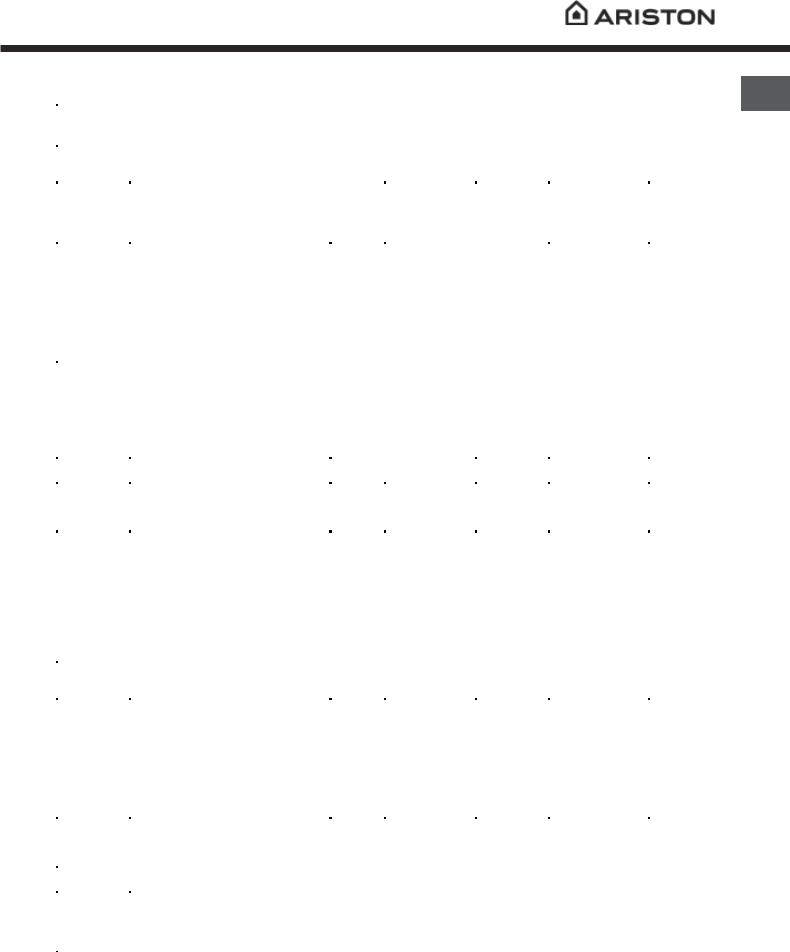
Cooking advice table
GB
|
Cooking |
Foods |
Weight |
Rack Position |
Pre-heating |
Recommended |
Cooking |
|
|
modes |
|
(in kg) |
|
time |
temperature |
time |
|
|
|
|
|
|
(minutes) |
|
(minutes) |
|
|
Leavening |
Leavening process of dough made with |
|
|
|
|
|
|
|
yeast or baking powder (brioches, bread, |
|
|
|
|
|
|
|
|
|
sugar pie, croissants, etc.) |
|
|
|
|
|
|
|
|
Duck |
1 |
3 |
15 |
200 |
65-75 |
|
|
Traditional |
Roast veal or beef |
1 |
3 |
15 |
200 |
70-75 |
|
|
Oven |
Pork roast |
1 |
3 |
15 |
200 |
70-80 |
|
|
Biscuits (short pastry) |
- |
3 |
15 |
180 |
15-20 |
|
|
|
|
|
||||||
|
|
Tarts |
1 |
3 |
15 |
180 |
30-35 |
|
|
|
Tarts |
0.5 |
3 |
15 |
180 |
20-30 |
|
|
|
Fruit cakes |
1 |
2 or 3 |
15 |
180 |
40-45 |
|
|
|
Plum cake |
0.7 |
3 |
15 |
180 |
40-50 |
|
|
Baking |
Sponge cake |
0.5 |
3 |
15 |
160 |
25-30 |
|
|
Stuffed pancakes (on 2 racks) |
1.2 |
2 and 4 |
15 |
200 |
30-35 |
|
|
|
Mode |
Small cakes (on 2 racks) |
0.6 |
2 and 4 |
15 |
190 |
20-25 |
|
|
|
Cheese puffs (on 2 racks) |
0.4 |
2 and 4 |
15 |
210 |
15-20 |
|
|
|
Cream puffs (on 3 racks) |
0.7 |
1 and 3 and 5 |
15 |
180 |
20-25 |
|
|
|
Biscuits (on 3 racks) |
0.7 |
1 and 3 and 5 |
15 |
180 |
20-25 |
|
|
|
Meringues (on 3 racks) |
0.5 |
1 and 3 and 5 |
15 |
90 |
180 |
|
|
|
Frozen food |
|
|
|
|
|
|
|
|
Pizza |
0.3 |
2 |
- |
250 |
12 |
|
|
|
Courgette and prawn pie |
0.4 |
2 |
- |
200 |
20 |
|
|
|
Country style spinach pie |
0.5 |
2 |
- |
220 |
30-35 |
|
|
|
Turnovers |
0.3 |
2 |
- |
200 |
25 |
|
|
Fast |
Lasagne |
0.5 |
2 |
- |
200 |
35 |
|
|
Golden Rolls |
0.4 |
2 |
- |
180 |
25-30 |
|
|
|
cooking |
Chicken morsels |
0.4 |
2 |
- |
220 |
15-20 |
|
|
|
Pre-cooked food |
|
|
|
|
|
|
|
|
Golden chicken wings |
0.4 |
2 |
- |
200 |
20-25 |
|
|
|
Fresh Food |
|
|
|
|
|
|
|
|
Biscuits (short pastry) |
0.3 |
2 |
- |
200 |
15-18 |
|
|
|
Plum cake |
0.6 |
2 |
- |
180 |
45 |
|
|
|
Cheese puffs |
0.2 |
2 |
- |
210 |
10-12 |
|
|
|
Pizza (on 2 racks) |
1 |
2 and 4 |
15 |
230 |
15-20 |
|
|
|
Lasagne |
1 |
3 |
10 |
180 |
30-35 |
|
|
|
Lamb |
1 |
2 |
10 |
180 |
40-45 |
|
|
|
Roast chicken + potatoes |
1+1 |
2 and 4 |
15 |
200 |
60-70 |
|
|
Multi- |
Mackerel |
1 |
2 |
10 |
180 |
30-35 |
|
|
Plum cake |
1 |
2 |
10 |
170 |
40-50 |
|
|
|
cooking |
|
||||||
|
Cream puffs (on 2 racks) |
0.5 |
2 and 4 |
10 |
190 |
20-25 |
|
|
|
|
|
||||||
|
|
Biscuits (on 2 racks) |
0.5 |
2 and 4 |
10 |
180 |
10-15 |
|
|
|
Sponge cake (on 1 rack) |
0.5 |
2 |
10 |
170 |
15-20 |
|
|
|
Sponge cake (on 2 racks) |
1 |
2 and 4 |
10 |
170 |
20-25 |
|
|
|
Savoury pies |
1.5 |
3 |
15 |
200 |
25-30 |
|
|
Pizza Mode |
Pizza |
0.5 |
3 |
15 |
220 |
15-20 |
|
|
Roast veal or beef |
1 |
2 |
10 |
220 |
25-30 |
|
|
|
|
Chicken |
1 |
2 or 3 |
10 |
180 |
60-70 |
|
|
|
Soles and cuttlefish |
0.7 |
4 |
- |
Max |
10-12 |
|
|
|
Squid and prawn kebabs |
0.6 |
4 |
- |
Max |
8-10 |
|
|
|
Cuttlefish |
0.6 |
4 |
- |
Max |
10-15 |
|
|
|
Cod filet |
0.8 |
4 |
- |
Max |
10-15 |
|
|
|
Grilled vegetables |
0.4 |
3 or 4 |
- |
Max |
15-20 |
|
|
|
Veal steak |
0.8 |
4 |
- |
Max |
15-20 |
|
|
Barbecue |
Sausages |
0.6 |
4 |
- |
Max |
15-20 |
|
|
Hamburgers |
0.6 |
4 |
- |
Max |
10-12 |
|
|
|
|
|
||||||
|
|
Mackerels |
1 |
4 |
- |
Max |
15-20 |
|
|
|
Toasted sandwiches (or toast) |
4 and 6 |
4 |
- |
Max |
3-5 |
|
|
|
With rotisserie (where present) |
|
|
|
|
|
|
|
|
Veal on the spit |
1.0 |
- |
- |
Max |
80-90 |
|
|
|
Chicken on the spit |
1.5 |
- |
- |
Max |
70-80 |
|
|
|
Lamb on the spit |
1.0 |
- |
- |
Max |
70-80 |
|
|
|
Grilled chicken |
1.5 |
2 |
10 |
200 |
55-60 |
|
|
|
Cuttlefish |
1.5 |
2 |
10 |
200 |
30-35 |
|
|
Gratin |
With rotisserie (where present) |
|
|
|
|
|
|
|
Veal on the spit |
1.5 |
- |
10 |
200 |
70-80 |
|
|
|
|
Lamb on the spit |
1.5 |
- |
10 |
200 |
70-80 |
|
|
|
Chicken on the spit + |
1.5 |
- |
10 |
200 |
70-75 |
|
|
|
potatoes (roasted) |
- |
2 |
10 |
200 |
70-75 |
|
|
|
|
|
|
|
|
|
|
9

Precautions and tips
! The appliance was designed and manufactured in GB compliance with international safety standards. The
following warnings are provided for safety reasons and must be read carefully.
General safety
•The appliance was designed for domestic use inside the home and is not intended for commercial or industrial use.
•The appliance must not be installed outdoors, even in covered areas. It is extremely dangerous to leave the appliance exposed to rain and storms.
•When handling the appliance, always use the handles provided on the sides of the oven.
•Do not touch the appliance with bare feet or with wet or moist hands and feet.
•The appliance must be used to cook food by adults only and according to the instructions in this manual.
•When the appliance is in use, the heating elements and some parts of the oven door become extremely hot. Make sure you don't touch them and keep children well away.
•Ensure that the power supply cable of other electrical appliances does not come into contact with the hot parts of the oven.
•The openings used for ventilation and dispersion of heat must never be covered.
•Always grip the oven door handle in the centre: the ends may be hot.
•Always use oven gloves to place cookware in the oven or when removing it.
•Do not use aluminium foil to line the bottom of the oven.
•Do not place flammable materials in the oven: if the appliance is switched on by mistake, it could catch fire.
•Always make sure the knobs are in the “l”/“¡” position when the appliance is not in use.
•When unplugging the appliance always pull the plug from the mains socket, do not pull on the cable.
•Never carry out any cleaning or maintenance work without having unplugged the plug from the mains.
•In the case of a malfunction, under no circumstances should you attempt to repair the appliance yourself. Repairs carried out by inexperienced persons may cause injury or further malfunctioning of the appliance. Contact a Service Centre (see Assistance).
•Do not rest heavy objects on the open oven door.
Disposal
•Observe local environmental standards when disposing packaging material for recycling purposes. Observe existing legislation when disposing of the old appliance.
•The European Directive 2002/96/EC on Waste Electrical and Electronic Equipment (WEEE), requires that old household electrical appliances must not be disposed of in the normal unsorted municipal waste stream. Old appliances must be collected separately in order to optimise the recovery and recycling of the materials they contain and reduce the impact on human health and the environment. The crossed out “wheeled bin” symbol on the product reminds you of your obligation, that when you dispose of the appliance it must be separately collected. Consumers should contact their local authority or retailer for information concerning the correct disposal of their old appliance.
Respecting and conserving the environment
•By using the appliance in the hours between late afternoon and early morning, you can help reduce the work load placed on electrical companies.
•Always keep the oven door closed when using the BARBECUE and GRATIN modes: to attain best results and to save energy (approximately 10%).
•Regularly check the door seals and wipe clean to ensure they are free of debris so that they stick properly to the door and do not allow heat to disperse.
Assistance
Communicating:
•appliance model (Mod.)
•serial number (S/N)
This information is found on the data plate located on the appliance and/or on the packaging.
10
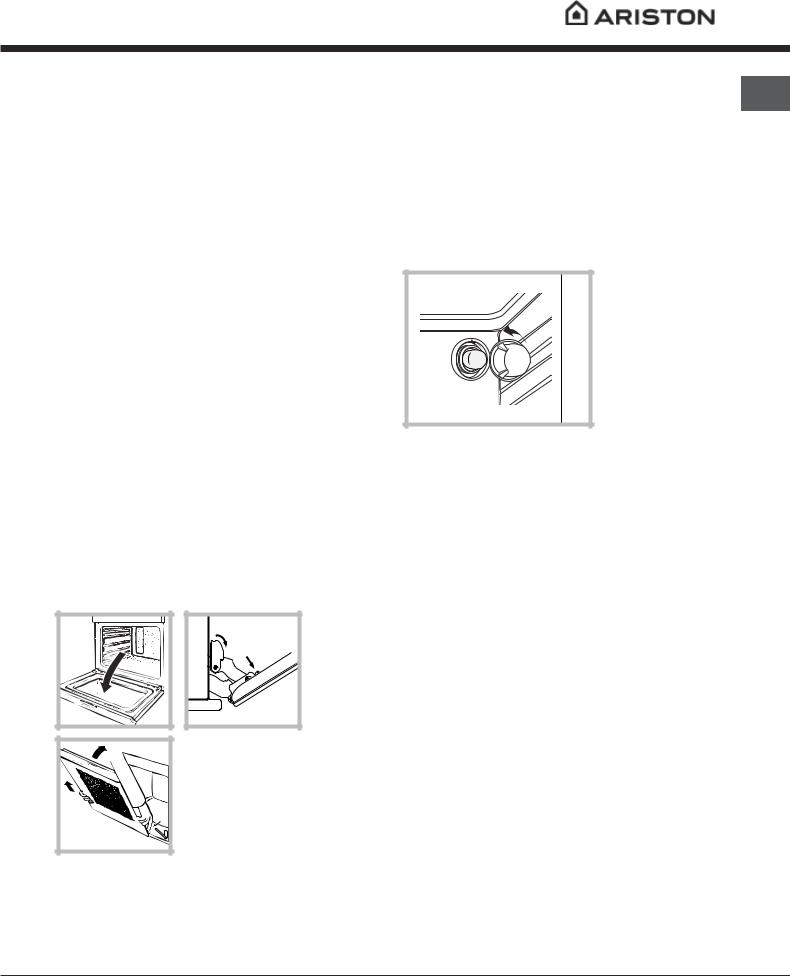
Maintenance and care
Switching the appliance off
Disconnect your appliance from the electricity supply before carrying out any work on it.
Cleaning the appliance
•The stainless-steel or enamel-coated external parts as well as the rubber seals may be cleaned using a sponge that has been soaked in lukewarm water and neutral soap. If these stains are difficult to remove, use only specialised products. After cleaning, rinse and dry thoroughly. Do not use abrasive powders or corrosive substances.
•Ideally, the inside of the oven should be cleaned after each use, when it is still lukewarm. Use hot water and detergent, rinse and dry with a soft cloth. Do not use abrasive products.
•All accessories - with the exception of the sliding
racks - can be washed like everyday crockery.
Never use steam cleaners or pressure cleaners on the appliance.
Cleaning the oven door
Clean the glass part of the oven door using a sponge and a non-abrasive cleaning product, then dry thoroughly with a soft cloth. Do not use rough abrasive material or sharp metal scrapers as these could scratch the surface and cause the glass to crack.
To clean more thoroughly, you can remove the oven door.
1.Open the oven door fully (see diagram).
2.Lift up and turn the small levers located on the two hinges (see diagram).
F |
F |
3. Grip the door on the two external sides and close it approximately half way.
Unlock the door by pressing on the clamps F, then pull the door towards you lifting it out of its seat (see diagram).
To replace the door, reverse this sequence.
Inspecting the seals
Check the door seals around the oven periodically. If GB the seals are damaged, please contact your nearest After-sales Service Centre (see Assistance). We
recommend not using the oven until the seals have been replaced.
Replacing the light bulb
To replace the oven light bulb:
1. Remove the glass cover of the lamp-holder.
2. Remove the
light bulb and replace it with a similar one:
Wattage 25 W,
cap E 14.
3. Replace the glass cover (see
diagram).
11

Brugervejledning
OVN
|
|
|
|
|
|
|
|
|
|
|
|
|
|
|
|
|
Oversigt |
|
DK |
|
|
|
|
|
|
|
|
|
|
|
|
|
|
||
|
|
|
|
|
|
|
|
Installation, 13-14 |
|
|
|
GB |
|
|
|
|
|
|
|
|
|
DK |
|
NO |
Placering |
|
|
|
|
|
|
|
|
|
Elektrisk tilslutning |
|
|
|
|
|
|
|
|
|
English,1 Dansk, 12 Norsk,23
FI |
|
SE |
|
|
|
|
|
Suomi, 34 |
Svenska, 45 |
||
F86.1
F86.1 IX FQ 860.1 NE FZ 860.1 NE
FZ 860.1 IX NE
Beskrivelse af ovnen, 15
Samlet illustration
Betjeningspanel
Start og brug, 16
Sådan tændes for ovnen
Typeskilt
Elektronisk programmeringsenhed til tilberedning, 17
Programmer, 18-20
Tilberedningsprogrammer
Praktiske råd til tilberedning
Skema over tilberedning
Forskrifter og råd, 21
Generelt om sikkerheden Bortskaffelse
Spar på energien og værn om miljøet
Vedligeholdelse, 22
Afbrydelse af strømmen Rengøring af apparatet Rengøring af ovndøren Udskiftning af pære Service
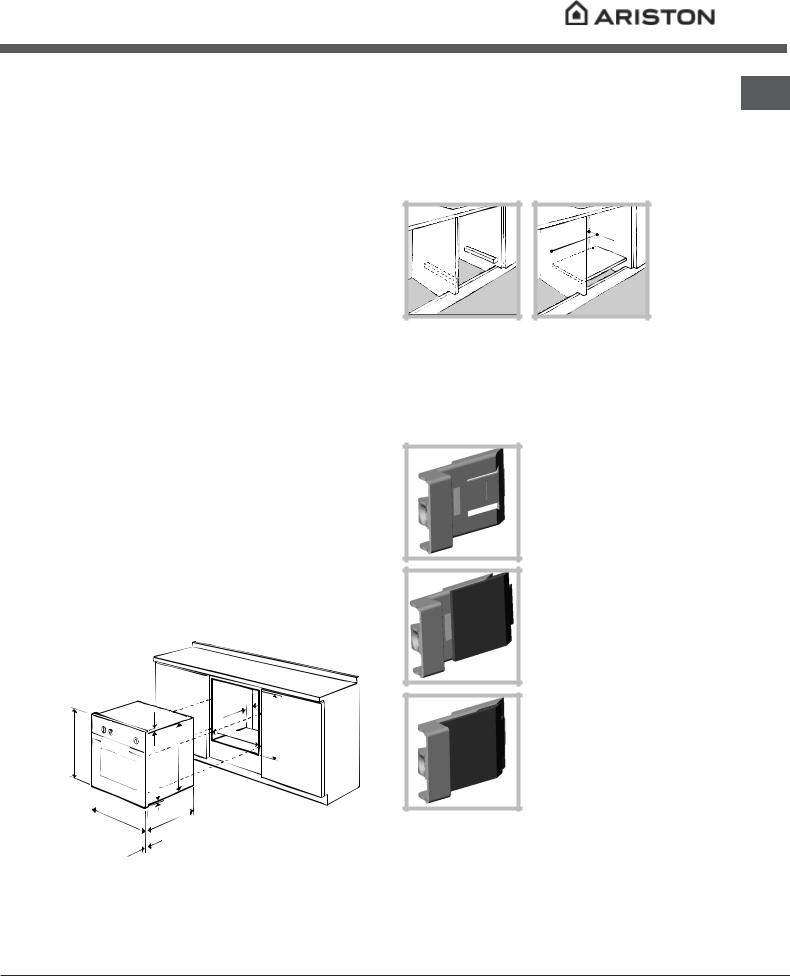
Installation
Det er vigtigt at opbevare dette hæfte et sted, så det nemt kan konsulteres. Hvis apparatet sælges, overdrages eller flyttes, skal man sørge for, at brugervejledningen følger med, så den nye ejer kan få oplysninger om apparatets funktion og eventuelle advarsler.
Læs omhyggeligt instruktionerne: De indeholder vigtige oplysninger om installation, anvendelse og sikkerhed.
Placering
Emballagen må ikke betragtes som legetøj til børn, og den skal bortskaffes i henhold til bestemmelserne om sortering af affald (se afsnittet Forskrifter og råd).
Installationen skal udføres i overensstemmelse med instruktionerne og af en kvalificeret tekniker. En fejlagtig installation kan medføre personskade, skader på dyr samt materielle skader.
Indbygning
For at ovnen skal kunne fungere korrekt, skal indbygningsskabet være egnet dertil:
•Panelerne på skabene ved siden af ovnen skal være lavet af materialer, der er modstandsdygtige over for varme.
•På skabe af finerplader skal limen være modstandsdygtig over for temperaturer på 100ºC.
•Hvis ovnen indbygges i et skab, både ved montering under en bordplade (se figuren) og ved søjleopbygning, skal skabet have følgende mål:
595 mm. |
23 mm. |
567 mm. |
|
|
5 mm. |
|
. |
mm |
|
45 |
|
558 |
mm. |
|
|
593 mm.
595 |
mm. |
. |
|
mm |
|
|
|
545 |
|
. |
|
|
mm |
|
24 |
|
|
Når ovnen er blevet indbygget, må der ikke være mulighed for eventuelt kontakt med de elektriske dele. Oplysningerne om energiforbrug, angivet på typeskiltet, er målt på denne type installation.
Ventilation
DK
For at sikre en god ventilation, er det nødvendigt at afmontere den bageste væg på indbygningsskabet. Det tilrådes at installere ovnen, så den støtter på to trælister eller på en plan overflade med en åbning på minimum 45 x 560 mm (se figuren).
. |
45 |
mm |
mm |
|
|
|
. |
|
560 |
|
|
Centrering og fastgørelse
Placér de 4 stifter på siden af ovnen ud for de 4 huller på omkredsrammen, idet der tages hensyn til køkkenelementets tykkelse:
Tykkelse på 20 mm: Fjern den bevægelige del af den udragende stift (se figuren).
Tykkelse på 18 mm: Brug den første rille, som allerede findes ved levering fra fabrikken (se
figuren).
Tykkelse på 16 mm: Brug den anden rille (se figuren).
Sådan fastgøres ovnen til køkkenelementet: Åbn ovndøren, og skru de 4 skruer i de 4 passende huller på omkredsrammen.
Alle sikkerhedsdele skal være monteret på en sådan måde, at de ikke kan fjernes uden brug af værktøj.
13
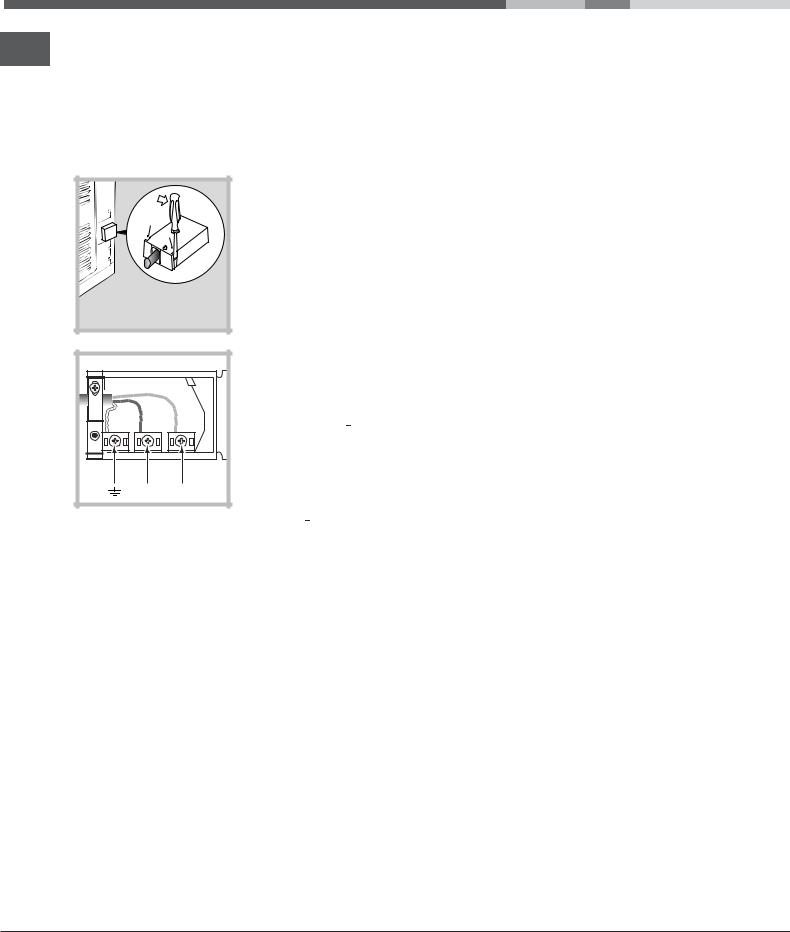
Elektrisk tilslutning
DK
Ovne, der er udstyret med et trepolet forsyningskabel er klargjort til funktion med vekselstrøm ved den spænding og frekvens, der er anført på ovnens typeskilt (se herunder).
Montering af forsyningskabel |
1. Åbn klemrækken ved |
at stikke en |
skruetrækker ned i |
klapperne på siden af |
dækslet. Træk og åbn |
dækslet (se figuren). |
N L
figuren).
2. Tilslutning af forsyningskablet: Drej skruen af kabelklemmen og de tre skruer af kontakterne L-N- og fastgør de små ledninger under skruehovederne i overensstemmelse med farverne Blå (N) Brun (L) Gul-grøn
og fastgør de små ledninger under skruehovederne i overensstemmelse med farverne Blå (N) Brun (L) Gul-grøn  (se
(se
3.Spænd ledningen fast i den passende kabelklemme.
4.Luk dækslet på kabelrækken.
Tilslutning af strømforsyningskablet til nettet
Anvend et standardstik på kablet til den belastning, der er anført på typeskiltet (se her ved siden af). Hvis man ønsker en direkte forbindelse til el-nettet, skal man indsætte en flerpolet afbryder med en minimumsåbning mellem kontakterne på 3 mm. i overensstemmelse med belastningen og i
overensstemmelse med de gældende regler (der skal ikke være en afbryder på jordforbindelsen). Forsyningskablet skal være placeret på en sådan måde, at det ikke når en temperatur på 50º C over omgivelsestemperaturen på noget punkt.
Installatøren er ansvarlig for en korrekt elektrisk tilslutning samt overholdelse af sikkerhedsreglerne. Inden tilslutningen udføres, skal man kontrollere følgende:
•at stikkontakten har jordforbindelse og er i overensstemmelse med loven,
•at stikkontakten kan bære apparatets maksimale spændingsbelastning, som angivet på typeskiltet (se herunder),
•at forsyningsspændingen ligger inden for værdierne, som angivet på typeskiltet (se herunder),
•at stikkontakten passer til apparatets stik. I modsat fald skal man udskifte stikkontakten eller stikket. Undgå anvendelse af forlængerledninger eller flerdobbelte stikdåser.
Når apparatet er installeret, skal man nemt kunne nå ind til både ledning og stikkontakt.
Ledningen må ikke bøjes eller trykkes sammen.
Ledningen skal regelmæssigt kontrolleres og må kun udskiftes af autoriserede teknikere (se afsnittet
Service).
Virksomheden fralægger sig ethvert ansvar, såfremt disse regler ikke overholdes.
14
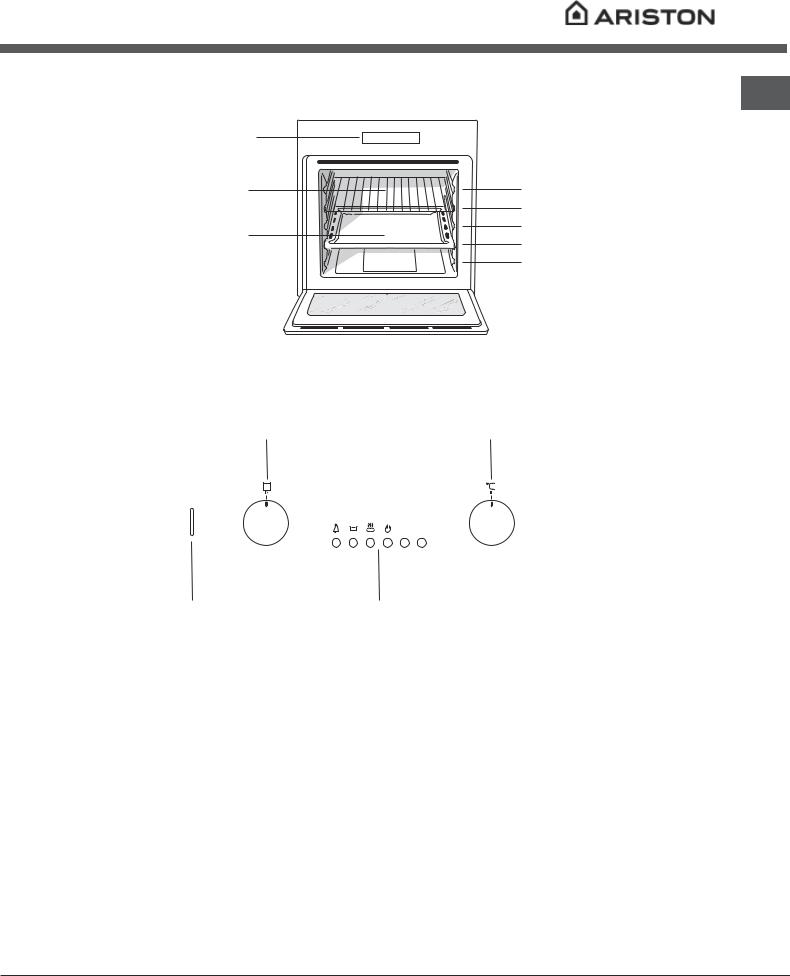
Beskrivelse af apparatet
Samlet illustration
DK
Betjeningspanel |
GLIDESKINNER |
|
|
til pladerne |
|
RIST |
rille 5 |
|
|
rille 4 |
|
BRADEPANDE |
rille 3 |
|
rille 2 |
||
|
||
|
rille 1 |
Betjeningspanel
PROGRAMVÆLGER |
TERMOSTATKNAP |
||||||
|
|
|
|
|
|
|
|
|
|
|
|
|
|
|
|
|
|
|
|
|
|
|
|
|
|
|
|
|
|
|
|
|
|
|
|
|
|
|
|
Kontrollampe for |
ELEKTRONISK |
TERMOSTAT |
programmeringsenhed |
15
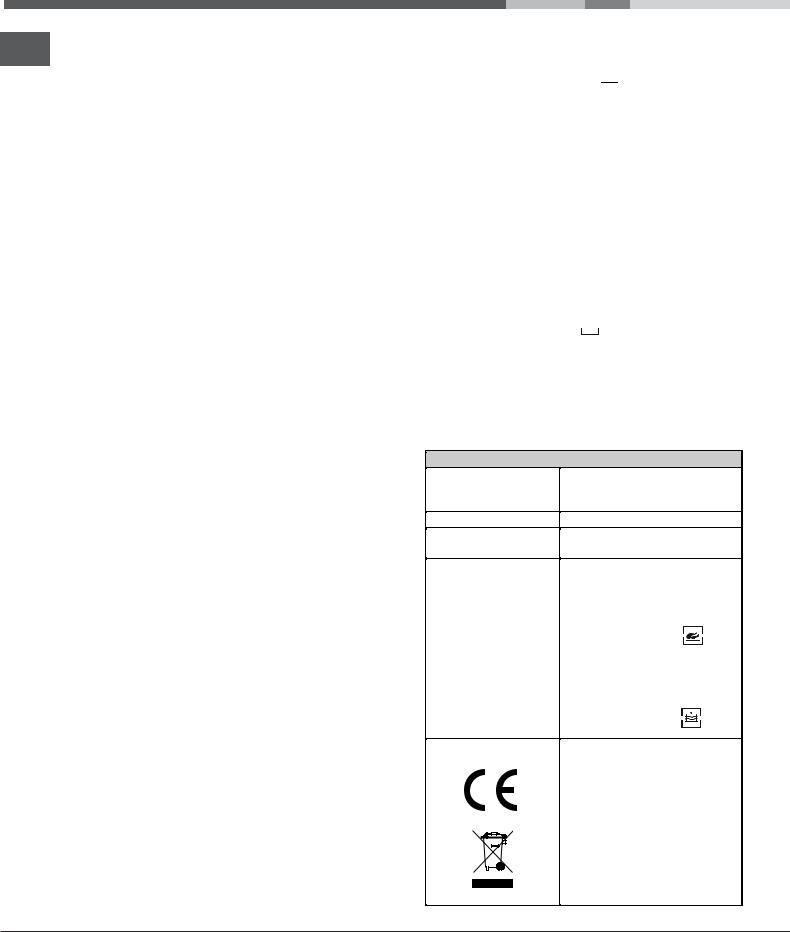
Start og brug
Når ovnen tændes første gang, anbefales det at lade DK ovnen være i funktion i tom tilstand i mindst en time
med termostaten indstillet på maksimum og ovndøren lukket. Herefter skal man åbne ovndøren og udlufte lokalet. Lugten, der opstår, skyldes fordampning af beskyttelsesmidlerne i ovnen.
Sådan tændes for ovnen
1.Vælg det ønskede tilberedningsprogram ved at dreje på PROGRAMKNAPPEN.
2.Indstil temperaturen ved at dreje på knappen TERMOSTAT. Der findes en liste over tilberedninger og de anbefalede temperaturer i tilberedningsskemaet
(se afsnittet Programmer).
3.Kontrollampen TERMOSTAT angiver, at ovnen er i gang med at varme op til den valgte temperatur
4.Under tilberedningen er det altid muligt at:
-ændre programmet ved at dreje på PROGRAMKNAPPEN,
-ændre temperaturen ved hjælp af TERMOSTATKNAPPEN,
-afbryde tilberedningen ved at dreje PROGRAMKNAPPEN over på position “0”.
Undgå at placere genstande i bunden af ovnen, da det kan beskadige ovnens lakering.
Placér altid beholderne på den medfølgende rist.
På ovne udstyret med elektronisk programmeringsenhed, skal man ved brug af den
elektriske ovn trykke på tasten 

 (på displayet vises
(på displayet vises
symbolet  ), inden man vælger den ønskede tilberedningsfunktion.
), inden man vælger den ønskede tilberedningsfunktion.
Afkølingsventilation
For at mindske den udvendige temperatur, er nogle modeller udstyret med en afkølingsblæser. Blæseren skaber en luftstråle, der blæses ud gennem betjeningspanelet og ovndøren.
Ved afsluttet tilberedning fortsætter blæseren med at være tændt, indtil ovnen er passende afkølet.
Ovnlys
Lyset tændes ved at vælge  med knappen PROGRAMMER. Den bliver ved med at lyse, når der vælges et tilberedningsprogram.
med knappen PROGRAMMER. Den bliver ved med at lyse, når der vælges et tilberedningsprogram.
TYPESKILT
Mål |
bredde 43,5 cm |
højde 32 cm |
|
|
dybde 41,5 cm |
Volumen |
lt. 58 |
Elektriske |
spænding 220-240V ~ 50Hz |
tilslutninger |
maks. optaget effekt 2800W |
|
Direktiv 2002/40/EF på de |
|
elektriske ovnes etikette |
|
Standard EN 50304 |
|
Energiforbrug ved naturlig |
|
varmestrømning - |
ENERGIMÆRKNING |
opvarmningsfunktion: |
Traditionel ovn; |
|
|
Erklæret energiforbrug for |
|
klasse med forceret |
|
varmestrømning - |
|
opvarmningsfunktion: |
|
Fint bagværk. |
|
Dette apparat er i |
|
overensstemmelse med |
|
følgende EU-direktiver: |
|
73/23/EØF af 19/02/73 |
|
(Lavspænding) og |
|
efterfølgende ændringer - |
|
89/336/EØF af 03/05/89 |
|
(Elektromagnetisk |
|
kompatibilitet) og efterfølgende |
|
ændringer - 93/68/EØF af |
|
22/07/93 og efterfølgende |
|
ændringer. 2002/96/EF |
16

Elektronisk programmeringsenhed til tilberedning 
Giver mulighed for at programmere ovnen eller grillen på følgende funktioner:
•forsinket begyndelse af tilberedningen med indstillet varighed;
•øjeblikkelig begyndelse med indstillet varighed;
•minuttæller.
Tasternes funktion:
H : minuttæller, timer, minutter $ : varighed af tilberedningen % : afslutning af tilberedningen ( : manuel omskiftning
) : indstilling af tiden tilbage * : indstilling af tiderne frem
Sådan indstilles det digitale ur
Efter tilslutning til el-nettet, eller efter strømsvigt, blinker displayet med: 0.00
• Tryk samtidig på tasterne $ og %, slip igen , og indstil derefter klokkeslættet (inden 4 sekunder) med tasterne ) og * .
Med tasten * stilles tiden frem. Med tasten ) stilles tiden tilbage.
Eventuel opdatering af klokkeslættet kan udføres på to forskellige måder:
1.Gentag ovennævnte handlinger
2.Tryk på tasten (, slip den igen, og indstil derefter klokkeslættet med tasterne ) og * .
Manuel ovnfunktion
Efter at have indstillet klokkeslættet, skifter programmeringsenheden automatisk til den manuelle position.
Bemærk:Tryk på tasten (for at genoprette den manuelle funktion efter hver ”Automatisk” tilberedning.
Forsinket start af tilberedningen med indstillet
varighed
Her indstilles tilberedningens varighed og klokkeslættet for afslutningen. Hvis man for eksempel antager, at displayet viser klokken 10.00
1.Drej ovnens betjeningsknapper hen på den ønskede funktion og temperatur (for eksempel: statisk ovn, 200°C)
2.Tryk på tasten $, slip den igen,og indstil derefter varigheden (inden 4 sekunder) med tasterne ) og *
. Hvis man for eksempel antager, at der indstilles en tilberedning på 30 minutter, vises følgende:
+
Efter indtastningen vises det nuværende
klokkeslæt efter 4 sekunder med symbolet m og teksten “auto”
3.Tryk på tasten %, slip den igen og tryk derefter på tasterne ) og * for at indstille tidspunktet for den ønskede afslutning af tilberedningen til for eksempel kl. 13.00
=
4. Efter indtastningen vises det nuværende klokkeslæt |
DK |
på displayet efter 4 sekunder: |
?
Når teksten ”auto” er tændt, betyder det, at der er programmeret varighed og afslutning af tilberedningen på den automatiske funktion. Herefter vil ovnen automatisk tænde kl. 12.30 og slukke efter 30 minutter. Når ovnen er tændt, lyser den lille gryde m i hele tilberedningens varighed. Det vil når som helst være muligt at se den indstillede varighed ved at trykke på tasten $ . Ved tryk på tasten % vises tidspunktet for afslutning af tilberedningen.
Når tilberedningen afbrydes, udsendes der et lydsignal. Dette signal slukkes ved tryk på en vilkårlig tast, blot ikke tasterne ) og *.
Øjeblikkelig start med indstillet varighed
Ved kun at programmere varigheden (punkterne 1 og 2 i afsnittet ” Forsinket begyndelse af tilberedningen med indstillet varighed” startes tilberedningen med det samme.
Annullering af en allerede programmeret tilberedning
Tryk på tasten $, slip den igen , og med tasten ) indstilles tiden til
,
og tryk derefter på tasten for manuel funktion (.
Minuttæller
Ved funktion med minuttæller indstilles en tid, hvorfra der påbegyndes en nedtælling. Denne funktion styrer ikke tænding og slukning af ovnen, men udsender blot en lydalarm, når tiden udløber.
Ved at trykke på tasten og slippe den igen vises
følgende:
,
Indstil derefter den ønskede tid med tasterne * og ). Efter indtastningen starter tiden med det samme, og på
displayet vises det nuværende klokkeslæt.
.
Når tiden udløber udsendes der et lydsignal, der kan slukkes ved at trykke på en vilkårlig tast (undtagen tasterne * og )), og symbolet H slukkes.
Korrektion og sletning af de indførte data
•De indstillede data kan ændres når som helst ved at trykke på den pågældende tast og derefter på tasten * eller ).
•Ved sletning af tilberedningens varighed, slettes også afslutningen automatisk og vice versa.
•Ved programmeret funktion accepterer apparatet ikke tider for afslutning af tilberedningen, der er før tiderne for begyndelse af tilberedningen, som apparatet selv foreslår.
17
